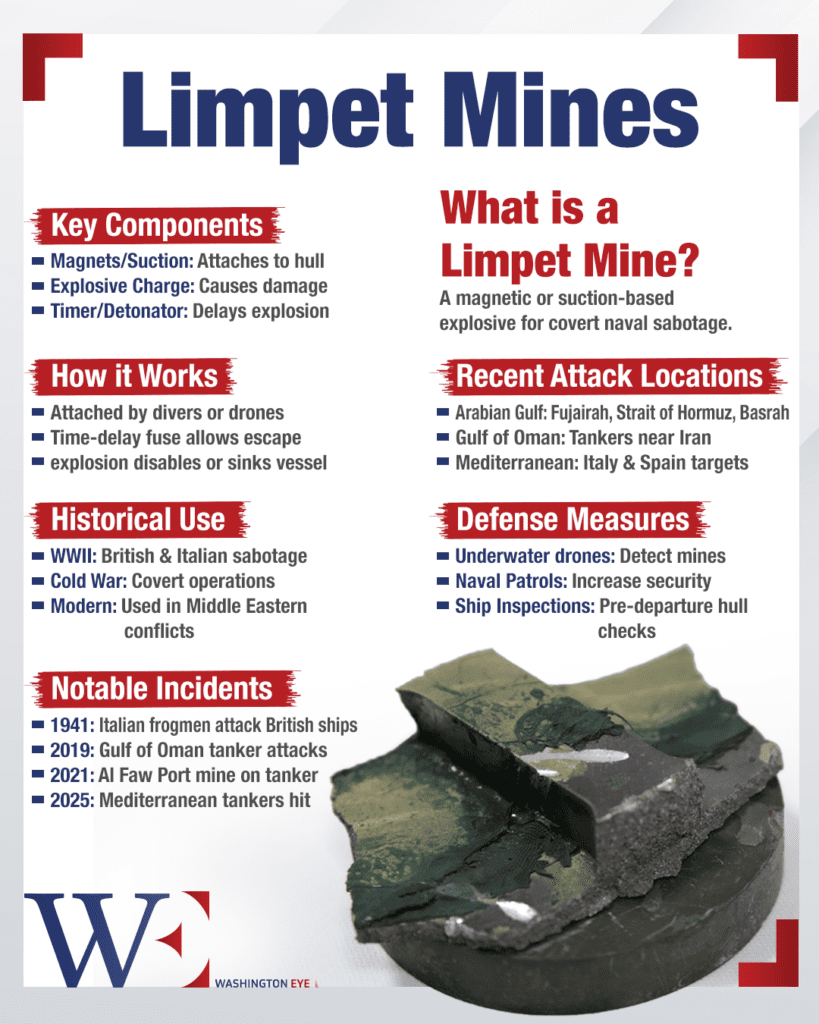A Stealthy Maritime Threat Returns
The Mediterranean Sea, long regarded as one of the world’s busiest and most secure maritime trade routes, has recently become the backdrop for a new wave of maritime sabotage. In early 2025, the tranquil waters were disrupted by a series of mysterious explosions targeting oil tankers linked to Russian port calls. What at first appeared to be mechanical malfunctions or minor onboard fires soon revealed a far more insidious reality—these vessels had been struck by limpet mines, an old but highly effective naval weapon.
The resurgence of limpet mines is both unexpected and alarming. These devices, which harken back to the days of World War II special operations, are rarely seen in European waters. More commonly associated with asymmetric warfare in the Arabian Gulf and the Gulf of Oman, their sudden appearance in the Mediterranean has raised a host of pressing questions. Who planted these mines? Where did they come from? And most importantly—why now?
What Is a Limpet Mine?
Limpet mines are a unique type of explosive, specifically designed for stealth and precision. Unlike torpedoes or missiles, which leave clear signatures and wreckage, limpet mines attach discreetly to a vessel’s hull and detonate with surgical accuracy. Named after the marine mollusk that clings to rocks, these mines use strong magnets or suction devices to affix themselves to ships, making them extremely difficult to detect and remove before detonation.
A key feature of limpet mines is their time-delay fuse. This mechanism allows attackers to escape the area before the mine explodes, ensuring minimal risk of detection. The triggering system can vary from simple mechanical timers to sophisticated electronic detonators, making it possible for an attacker to place a mine and leave the area without raising suspicion. In modern warfare, these devices are favored for their ability to cripple ships while leaving little evidence of the perpetrator.
How Are They Attached?
Deploying a limpet mine requires a high level of skill and often specialized training. The most common method involves combat divers or special forces operatives swimming beneath a target vessel and manually affixing the mine to a strategic point on the hull, often near the engine room or keel. For even greater stealth, remotely operated vehicles (ROVs) and underwater drones can now be used to plant these devices without ever requiring a human presence near the target.
Timing and placement are crucial. A well-positioned mine can maximize damage, potentially sinking a vessel or rendering it inoperative for weeks or months. This level of precision is what makes limpet mines so dangerous—they allow attackers to inflict maximum disruption with minimal effort and almost no chance of interception.
The Dark History of Limpet Mines
The use of limpet mines in naval warfare is not new. Their origins trace back to the early 20th century, with some of the most legendary uses occurring during World War II.
In December 1941, Italian frogmen conducted a daring raid on the British fleet in Alexandria, Egypt. Using limpet mines, they crippled two Royal Navy battleships, HMS Queen Elizabeth and HMS Valiant, rendering them out of action for months. Similarly, British special operations forces made extensive use of limpet mines to sabotage Axis shipping during the war, deploying them in high-risk missions across Europe and Asia.
During the Cold War, intelligence agencies allegedly employed limpet mines in covert operations, targeting enemy naval assets in ways that would not be directly traceable. More recently, they have appeared in conflicts where asymmetric naval warfare plays a role, such as in attacks on oil tankers in the Arabian Gulf and the Gulf of Oman.
Gulf of Oman and Arabian Gulf Incidents
The use of limpet mines in recent years has been most pronounced in the waters of the Arabian Gulf and the Gulf of Oman, two regions critical to global energy supply chains.
On May 12, 2019, four oil tankers anchored off the Emirati port of Fujairah suffered explosions, causing damage that was later attributed to limpet mines. The attacks, which occurred in one of the world’s most closely monitored shipping lanes, were widely suspected to be the work of Iranian-backed operatives. The ships targeted belonged to Saudi Arabia, the UAE, and Norway, sending shockwaves through the global oil market and sparking fears of an escalation in regional tensions.
Just a month later, on June 13, 2019, another attack shook the maritime industry. Two oil tankers—the Kokuka Courageous and the Front Altair—were hit by limpet mines while sailing through the Gulf of Oman. Video footage released by U.S. intelligence showed what appeared to be Iranian Revolutionary Guard Corps (IRGC) forces removing an unexploded mine from the hull of the Kokuka Courageous. The incident led to heightened security patrols and calls for enhanced maritime protection in the region.
In another alarming event on January 31, 2021, a limpet mine was discovered attached to the MT Pola, a Liberian-flagged tanker anchored near Iraq’s Al Faw Port, close to the Al Basrah Oil Terminal. Fortunately, the mine was safely removed before detonation, but the incident highlighted the persistent threat of maritime sabotage in key oil export routes.
Between 2021 and 2023, several additional attacks were reported near the Strait of Hormuz, reinforcing the notion that limpet mines had become a favored tool for regional proxy conflicts and asymmetric warfare. The latest incidents in the Mediterranean suggest that this deadly tactic is now spreading beyond the Arabian Gulf.
Recent Use in the Mediterranean
The sudden reappearance of limpet mine attacks in the Mediterranean has caught security analysts off guard. While such incidents have become familiar in Middle Eastern waters, they are virtually unheard of in Europe. Yet in early 2025, multiple tankers—including the Greek-owned Seacharm and Seajewel—were struck by explosions off the coasts of Italy and Spain.
Investigations suggest that these attacks involved Soviet-era BPM-type limpet mines, devices known for their reliability and destructive capability. The question now is: Who is responsible? Are these weapons remnants of old Soviet stockpiles, or is a new actor producing and deploying them in European waters?
Possible Links to the Ukraine Conflict
One of the most pressing concerns surrounding these attacks is their potential connection to the ongoing Russia-Ukraine war. Several factors suggest a link:
- Soviet-Origin Weapons: The BPM-type limpet mines used in the Mediterranean incidents were originally developed in the Soviet Union, making it possible that they were sourced from old Eastern European stockpiles.
- Targeting of Russian Energy Interests: The attacked vessels had ties to Russian oil shipments, leading to speculation that an adversary—possibly Ukraine or another Western-aligned group—is attempting to disrupt Russian trade.
- Ukrainian Special Forces Capabilities: Ukraine has demonstrated sophisticated naval warfare capabilities, including drone and sabotage attacks on Russian maritime assets. These attacks fit within their known operational tactics.
However, another possibility looms—false flag operations. Could Russian intelligence agencies be staging these attacks to justify escalations elsewhere? The lack of clear attribution keeps maritime security analysts guessing.
Limpet mines, once relics of past wars, have reemerged as a critical threat to modern maritime security. Their recent use in the Mediterranean suggests a troubling evolution in naval warfare, where stealth, precision, and disruption take precedence over traditional direct conflict.
Whether these incidents are a prelude to a larger confrontation or isolated acts of sabotage, one thing is certain—no vessel is safe from the silent menace of limpet mines. In an era where hybrid warfare dominates, the Mediterranean is now part of the growing battleground for covert naval operations.

















